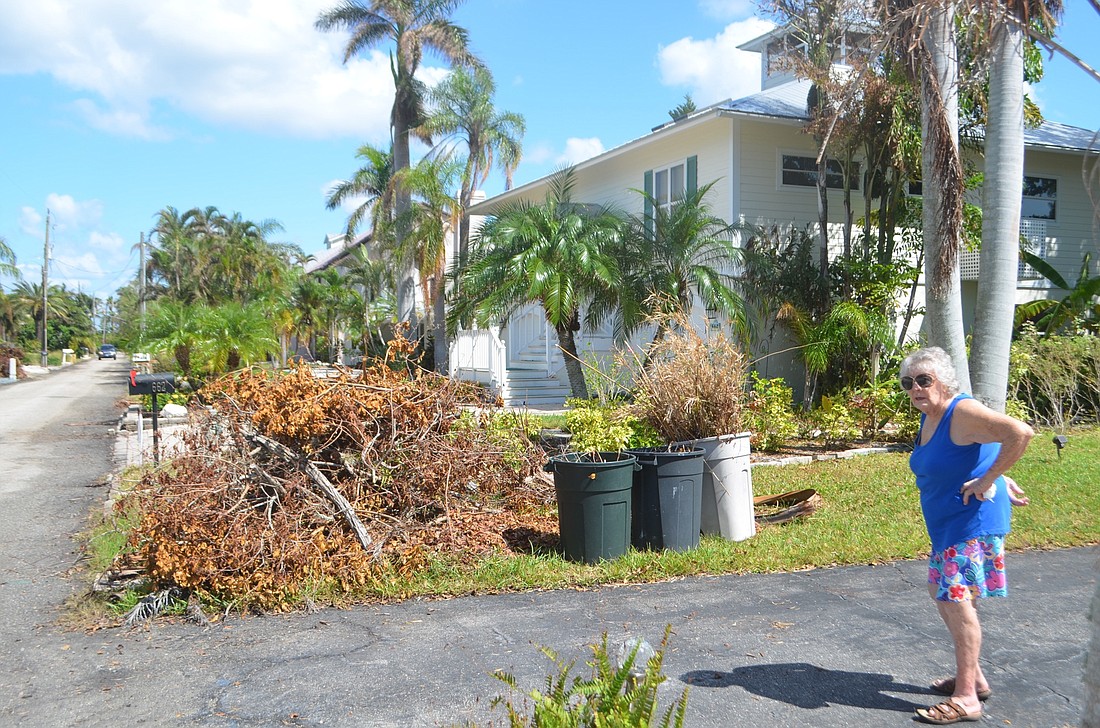- April 11, 2025
-
-
Loading

Loading

Nearly a month after Hurricane Irma, Arden Kreisch has a pile of debris taller than she is on her north-side property.
"It’s starting to look like the debris is growing roots, it’s been here so long,” Kreisch said.
The longtime resident is among thousands of her Longboat Key neighbors who've had debris pile up around their homes in Irma's wake, but she is among a dwindling number with any storm wreckage remaining. After weeks of slow, but consistent progress, town officials say they believe the island is just a week or two away from returning to a debris-free community.
"We're closing in on it," Town Manager Dave Bullock said. "It hasn’t been real fast, but we ask for everyone’s patience.”
As of early this week, the town had moved 9,500 cubic yards of debris off the island, which equates to about 950 typical dump trucks. Trucks from two contractors as well as the town's own fleet have worked every day for nearly three weeks hauling debris off the island. Town officials aren't sure exactly how much debris remains but, they're confident they're getting close.
Projections ahead of the storm estimated Irma, which hit Longboat on Sept. 10-11, would leave 10,000 cubic yards of debris. Residents can see significant progress along Gulf of Mexico Drive as bundles of tree branches that lined Gulf of Mexico Drive for weeks have dwindled to just a few stacks as of mid-October.
Though there was scattered structural damage, Longboat largely escaped a catastrophe. But, a few uprooted trees and damaged signs actually delayed the rate of progress for debris collection by cutting off access to some locations.
Paying for it
Towns and cities arrange their own multiyear retainer commitments with contractors in case of a storm or other event that requires debris removal. Local governments can only use approved contractors if they want reimbursement from FEMA, though. Along with a 12.5% reimbursement from the Florida government, FEMA pays 75% of jurisdiction's debris-removal costs of these pre-negotiated contracts, meaning towns and cities are on the hook for the excess if they decide to pay more than the originally agreed-upon rate.
Communities to the south and east of the Sarasota area decided to pay more on their own to get their severe damage cleared faster, Bullock said, which lured more subcontractors to prioritize locations where they could get a bigger pay out.
Longboat's reached deals with contractors Ashbritt and Ceres to help on the island, which have hired subcontractors from as far away as Maryland and Louisiana. Because of the high demand across Florida, those companies haven't been able to commit more than a truck or two a day, slowing down debris collection.
“What we learned from this storm was what we suspected all along: You can have as many contracts as you want, but everyone uses the same five or six national debris companies," Bullock said. "How many trucks would they ever possibly be able to get here?”
Even with additional vehicles and manpower, debris collection is a time-consuming process. Workers first collect debris, then shred or chip it to better fit in a dump truck. That truck then takes the consolidated debris to one of two dump sites in Sarasota or Manatee counties, a process which takes an hour-and-a-half or more per trip.
Because Longboat didn't suffer any damage significant enough to affect day-to-day travel or operations of the town, Bullock said, so officials decided against paying up thousands of dollars of town money on a contractor that wouldn't see them receive FEMA reimbursement. He said the town would have to reconsider if there was more serious damage in a future event.
More on their own
Going forward, Bullock said the town will evaluate its own fleet of vehicles, which all automatically receives reimbursement for debris removal-related expenses. The town has considered buying a grappling truck, which uses a claw to pick up debris, for several years and Irma may help push this to the forefront of the town's priority list.
"My realistic expectation is we’re going to have to get ready for another big event," Bullock said. "We need to beef up our own fleet."
In the meantime, town officials are pleased at the progress they've made, even if it's taken longer than they hoped. Nearly all side and neighborhood roads have been cleared out and Gulf of Mexico Drive should be all clear in the next week or two, said Longboat Key Streets, Facilities, Parks & Recreation Manager Mark Richardson.
Residents with debris remaining are asked to secure their remaining debris in stackable bundles along the edges of their streets as removal services don't enter private residences. Richardson said they should also make sure they have everything out as soon as possible as contractors are closing in on their final sweeps for island debris, a day many town officials and residents are looking forward to.
"If we’re done in the next two weeks, and five weeks after the storm we’re completely cleaned up, that’s pretty good," Richardson said.